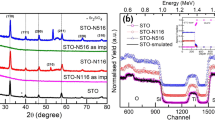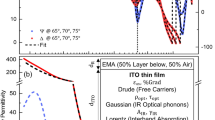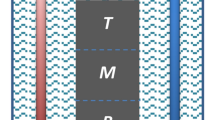Abstract
Developing fabrication methods for electronically active nanostructures is an important challenge of modern science and technology. Fabrication efforts1,2,3,4 for crystalline materials have been focused on state-of-the-art epitaxial growth techniques. These techniques are based on deposition of precisely controlled combinations of various materials on a heated substrate. We report a method that does not require deposition and transforms a nanoscale layer of a complex crystalline compound into a new material using low-energy ion-beam preferential etching (IBPE). We demonstrate this method by transforming a widely used5,6,7,8,9,10 insulator model system, SrTiO3, into a transparent conductor. Most significantly, the resistivity decreases with decreasing temperature as ∼T2.5±0.3 and eventually falls below that of room-temperature copper. These transport measurements imply a crystal quality in the conduction channel comparable to that obtained1 with the highest-quality growth techniques. The universality of low-energy IBPE implies wide potential applicability to fabrication of other nanolayers.
This is a preview of subscription content, access via your institution
Access options
Subscribe to this journal
Receive 12 print issues and online access
$259.00 per year
only $21.58 per issue
Buy this article
- Purchase on Springer Link
- Instant access to full article PDF
Prices may be subject to local taxes which are calculated during checkout




Similar content being viewed by others
References
Ohtomo, A. & Hwang, H. Y. A high-mobility electron gas at the LaAlO3/SrTiO3 heterointerface. Nature 427, 423–426 (2004).
Bozovic, I. et al. No mixing of superconductivity and antiferromagnetism in a high-temperature superconductor. Nature 422, 873–875 (2003).
Haeni, J. H. et al. Room-temperature ferroelectricity in strained SrTiO3 . Nature 430, 758–761 (2004).
Pallecchi, I. et al. SrTiO3-based metal-insulator-semiconductor heterostructures. Appl. Phys. Lett. 78, 2244–2246 (2001).
Muller, D. A., Nakagawa, N., Ohtomo, A., Grazul, J. L. & Hwang, H. Y. Atomic-scale imaging of nanoengineered oxygen vacancy profiles in SrTiO3 . Nature 430, 657–661 (2004).
Schooley, J. F., Hosler, W. R. & Cohen, M. L. Superconductivity in semiconducting SrTiO3 . Phys. Rev. Lett. 12, 474–475 (1964).
Bednorz, J. G. & Müller, K. A. Perovskite-type oxides - The new approach to high-Tc superconductivity. Rev. Mod. Phys. 60, 585–600 (1988).
Gopalan, S., Balu, V., Lee, J. H., Hee-Han, J. & Lee, J. C. Study of the electronic conduction mechanism in Nb-doped SrTiO3 thin films with Ir and Pt electrodes. Appl. Phys. Lett. 77, 1526–1528 (2000).
Ahn, C. H., Triscone, J. M. & Mannhart, J. Electric field effect in correlated oxide systems. Nature 424, 1015–1018 (2003).
Zhao, T. et al. Colossal magnetoresistive manganite-based ferroelectric field-effect transistor on Si. Appl. Phys. Lett. 84, 750–752 (2004).
Cooper, C. M., Nayar, P. S., Hale, E. B. & Gerson, R. Conductive strontium titanate layers produced by boron-ion implantation. J. Appl. Phys. 50, 2826–2831 (1979).
Albrecht, J. et al. Surface patterning of SrTiO3 by 30 keV ion irradiation. Surf. Sci. Lett. 547, L847–L852 (2003).
Yang, B., Townsend, P. D., Fan, Y. & Fromknecht, R. Effects of the ion-implantation on the thermoluminescence spectra of strontium titanate. Nucl. Instrum. Methods Phys. Res. B 226, 549–555 (2004).
Henrich, V. E., Dresselhaus, G. & Zeiger, H. J. Surface defects and the electronic structure of SrTiO3 surfaces. Phys. Rev. B 17, 4908–4921 (1978).
Nastasi, M., Mayer, J. W. & Hirvonen, J. K. Ion–Solid Interactions: Fundamentals and Applications (Cambridge Univ. Press, Cambridge, 1996).
Rabalais, J. W. (ed.) Low Energy Ion–Surface Interactions Ch. 9 (Wiley, Chichester, 1994).
Harper, J. M. E., Cuomo, J. J. & Kaufman, H. R. Technology and applications of broad-beam ion sources used in sputtering. Part II. Applications. J. Vac. Sci. Technol. 21, 737–756 (1982).
Tsuei, C. C., Gupta, A. & Koren, G. Quadratic temperature dependence of the in-plane resistivity in superconducting Nd1.85CuO4 - Evidence for Fermi-liquid normal state. Physica C 161, 415–422 (1989).
Frederikse, H. P., Hosler, W. R. & Thurber, W. R. Magnetoresistance of semiconducting SrTiO3 . Phys. Rev. 143, 648–651 (1966).
Lee, C., Yahia, J. & Brebner, J. L. Electronic conduction in slightly reduced strontium titanate at low temperatures. Phys. Rev. B 3, 2525–2533 (1971).
Tufte, O. N. & Chapman, P. W. Electron mobility in semiconducting strontium titanate. Phys. Rev. 155, 796–802 (1967).
Frederikse, H. P. R. & Hosler, W. R. Hall mobility in SrTiO3 . Phys. Rev. 161, 822–827 (1967).
Wenli, D., Ohgi, T., Nejo, H. & Fujita, D. Characteristics of indium tin oxide films deposited by DC and RF magnetron sputtering. Jpn J. Appl. Phys. 40, 3364–3369 (2001).
Maruyama, T. & Fukui, K. Indium tin oxide films prepared by chemical vapor deposition. J. Appl. Phys. 70, 3848–3851 (1991).
Rabalais, J. W. (ed.) Low Energy Ion–Surface Interactions Ch. 7 (Wiley, Chichester, 1994).
Acknowledgements
The authors would like to thank J. B. Chlistunoff, I. Campbell, T. Kimura and X. Gao for their help. This work was supported by the US Department of Energy.
Author information
Authors and Affiliations
Corresponding author
Ethics declarations
Competing interests
The authors declare no competing financial interests.
Rights and permissions
About this article
Cite this article
Reagor, D., Butko, V. Highly conductive nanolayers on strontium titanate produced by preferential ion-beam etching. Nature Mater 4, 593–596 (2005). https://doi.org/10.1038/nmat1402
Received:
Accepted:
Published:
Issue Date:
DOI: https://doi.org/10.1038/nmat1402
This article is cited by
-
Mobility enhancement in heavily doped semiconductors via electron cloaking
Nature Communications (2022)
-
Dopant-Tunable Ultrathin Transparent Conductive Oxides for Efficient Energy Conversion Devices
Nano-Micro Letters (2021)
-
Electrolyte-Gated Oxides
Journal of Superconductivity and Novel Magnetism (2020)
-
Amorphization kinetics in strontium titanate at 16 and 300 K under argon ion irradiation
Journal of Materials Science (2019)
-
Controllable Fabrication of Non-Close-Packed Colloidal Nanoparticle Arrays by Ion Beam Etching
Nanoscale Research Letters (2018)



